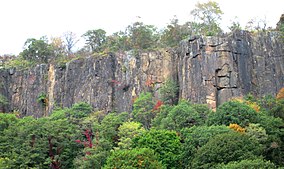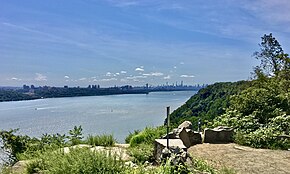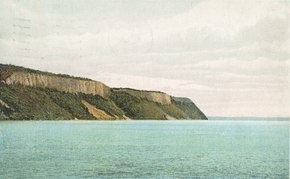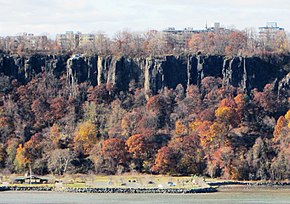The Palisades (Hudson River)
| The Palisades | |
|---|---|
 The cliffs of the Palisades as seen from the Ross Dock Picnic Area in Palisades Interstate Park | |
 | |
| Location | Northeastern New Jersey (Hudson and Bergen counties) Downstate New York (Rockland County) |
| Coordinates | 40°57′52″N 73°54′31″W / 40.96451°N 73.90859°W |
| Designated | 1983 |

The Palisades, also called the New Jersey Palisades or the Hudson River Palisades, are a line of steep cliffs along the west side of the lower Hudson River in Northeastern New Jersey and Southeastern New York in the United States. The cliffs stretch north from Jersey City about 20 miles (32 km) to near Nyack, New York, and are visible at Haverstraw, New York. They rise nearly vertically from near the edge of the river, and are about 300 feet (90 m) high at Weehawken, increasing gradually to 540 feet (160 m) high near their northern terminus.[1] North of Fort Lee, the Palisades are part of Palisades Interstate Park and are a National Natural Landmark.[2]
The Palisades are among the most dramatic geologic features in the vicinity of New York City, forming a canyon of the Hudson north of the George Washington Bridge, as well as providing a vista of the Manhattan skyline. They sit in the Newark Basin, a rift basin located mostly in New Jersey.
Palisade is derived from the same root as the word pole, ultimately from the Latin word palus, meaning stake. A "palisade" is, in general, a defensive fence or wall made up of wooden stakes or tree trunks. The Lenape called the cliffs "rocks that look like rows of trees", a phrase that became "Weehawken", the namesake of a town in New Jersey that sits at the top of the cliffs across from Midtown Manhattan.
Geology
[edit]The basalt cliffs are the margin of a diabase sill, formed about 200 million years ago,[3] at the close of the Triassic period, by the intrusion of molten magma upward into sandstone.[4] The molten material cooled and solidified before reaching the surface. Water erosion of the softer sandstone left behind the columnar structure of harder rock that exists today. The cliffs are about 300 ft (100 m) thick in sections and originally may have reached 1,000 ft (300 m).
The end-Triassic extinction event that coincided with the formation of the Hudson Palisades, Central Atlantic magmatic province, 200 million years ago ranks second in severity of the five major extinction episodes that span geologic time.[4][5]
Franklyn Van Houten completed groundbreaking research on a rock formation known as the Newark Basin. His discovery of a consistent geological pattern in which lake levels rose and fell is now known as the "Van Houten cycle".[6][7][8][9]
History
[edit]
The Palisades appear on the first European map of the New World, made by Gerardus Mercator in 1541 based on the description given him by Giovanni da Verrazzano,[10] who suggested they look like a "fence of stakes".[11]
During the early stages of the American Revolution, British military commander Lord Cornwallis landed a force of between 2,500 and 5,000 at Huyler's Landing on November 20, 1776.[12][13] In an effort to ambush American general George Washington and crush the rebellion in the wake of the rebels' defeat in the Battle of Long Island and the Battle of Fort Washington, Cornwallis marched his men up the steep Palisades and southward through the Northern Valley. Washington, stationed near Fort Lee, was alerted to the ambush effort by an unknown horseback patriot, remembered only as the Closter Rider, and successfully fled west through Englewood and over the Hackensack River, avoiding capture in what is remembered as Washington's Retreat.[14][15]
The Palisades were the site of 18 documented duels and probably many unrecorded ones in the years 1798–1845. The most famous is the Burr–Hamilton duel between Alexander Hamilton and Aaron Burr, which took place in a spot known as the Heights of Weehawken on July 11, 1804.[16]
An English visitor, Fanny Trollope, in her 1832 book Domestic Manners of the Americans, wrote of a park established at the Palisades by a Hoboken ferryboat entrepreneur at that time:
It is hardly possible to imagine one of greater attraction; a broad belt of light underwood and flowering shrubs, studded at intervals with lofty forest trees, runs for two miles along a cliff which overhangs the matchless Hudson; sometimes it feathers the rocks down to its very margin, and at others leaves a pebbly shore, just rude enough to break the gentle waves, and make a music which mimics softly the loud chorus of the ocean. Through this beautiful little wood, a broad well gravelled terrace is led by every point which can exhibit the scenery to advantage; narrower and wilder paths diverge at intervals, some into the deeper shadow of the wood, and some shelving gradually to the pretty coves below. The price of entrance to this little Eden, is the six cents you pay at the ferry.[17]
After the Civil War, signs advertising patent medicines and other products covered the rock face in letters 20 feet (6.1 m) high.[18]
In the 19th century, the cliffs were heavily quarried for railroad ballast, leading to local efforts to preserve them. Beginning in the 1890s, several unsuccessful efforts were made to turn much of the Highlands into a forest preserve. Fearing that they would soon be put out of business, quarry operators responded by working faster: in March 1898 alone, more than three tons of dynamite was used to bring down Washington Head and Indian Head in Fort Lee, New Jersey, producing several million cubic yards of traprock. The following year,[10] work by the New Jersey Federation of Women's Clubs led to the creation of the Palisades Interstate Park Commission, headed by George W. Perkins, which was authorized to acquire land between Fort Lee and Piermont, New York. Its jurisdiction was extended to Stony Point, New York in 1906.
In 1908, the State of New York announced plans to move Sing Sing Prison to Bear Mountain. Work was begun in the area near Highland Lake (renamed Hessian Lake) and in January 1909, the state purchased the 740-acre (3.0 km2) Bear Mountain tract. Conservationists, inspired by the work of the Palisades Interstate Park Commission, lobbied successfully for the creation of the Highlands of the Hudson Forest Preserve. However, the prison project was continued. Mary Williamson Averell, whose husband, Union Pacific Railroad president E. H. Harriman died in September of that year, offered the state another 10,000 acres (40 km2) and one million dollars toward the creation of a state park.

George Walbridge Perkins, who served as president of the Palisades Interstate Park Commission from its creation in 1900 until his death in 1920, with whom she had been working, raised another $1.5 million from a dozen wealthy contributors including John D. Rockefeller and J. P. Morgan. New York State appropriated a matching $2.5 million and the state of New Jersey appropriated $500,000 to build the Henry Hudson Drive (which would be succeeded by the Palisades Parkway in 1947). Ultimately, the Sing Sing relocation was discontinued.
In the 1910s, when Fort Lee was a center of film production, the cliffs were frequently used as film locations. The most notable of these films was The Perils of Pauline, a serial which helped popularize the term cliffhanger.[19]
In October 1931, after four years of construction, the George Washington Bridge opened between Upper Manhattan and Fort Lee.
On April 28, 1940, the Boy Scout Foundation of Greater New York announced the donation of 723 acres by John D. Rockefeller Jr. to establish a weekend camp for New York City Boy Scouts.[20]
In June 1983, the Palisades were designated a National Natural Landmark by the National Park Service.[21]
On May 12, 2012, a 10,000 ton rockfall just south of the state line left a 520-foot (160 m) scar on the cliffs.[18]
The Palisades is now a part of Palisades Interstate Park, a popular destination for hiking and other outdoor recreational activities, that also includes Harriman-Bear Mountain State Park, Minnewaska State Park Preserve and several other parks and historic sites in the region.
On June 23, 2015, officials of the South Korean conglomerate LG Group announced that their planned new North American headquarters building in Englewood Cliffs, New Jersey, which was originally designed to be 143 feet (44 m) tall, and would have broken the tree line on top of the Palisades, would be reduced to 69 feet (21 m) in height, thus preserving the contour of the ridge. The new building had been opposed by numerous conservation groups and politicians, including four former governors of New Jersey.[22]
See also
[edit]References
[edit]- ^ "Township of Palisade" on the Bergen County website
- ^ "National Natural Landmarks (U.S. National Park Service)". www.nps.gov. Retrieved April 15, 2019.
Year designated: 1983
- ^ Tirella, Tricia. "Spotlight on North Bergen". Palisade magazine; Summer 2010; Page 16.
- ^ a b Brannen, Peter. "Headstone for an Apocalypse" (op-ed) New York Times (August 6, 2013)
- ^ Chu, Jennifer. "Huge and widespread volcanic eruptions triggered the end-Triassic extinction" MIT News (March 21, 2013)
- ^ Structural Geology & Tectonics Group "Van Houten cycle" (illustration) on the Rutgers University website
- ^ Olsen. "Milankovich Cycles in Early Mesozoic Rift Basins of Eastern North America Provide Physical Stratigraphy and Time Scale for Understanding Basin Evolution" from Lamont Newsletter 13 (1986) pp. 6–7, on the Lamont–Doherty Earth Observatory website
- ^ MacPherson, Kita. "Franklyn Van Houten, expert on sedimentary rocks, dies at 96" News at Princeton (September 14, 2010) on the Princeton University website
- ^ Chalker, Georgette E. "Franklyn Bosworth Van Houten 1914–2010" Princeton University Department of Geosciences website (February 10, 2011)
- ^ a b Cheslow, Jerry (December 14, 1997). "If You're Thinking of Living in Alpine, N.J.; Lavish Homes in a Millionaire's Borough". The New York Times
- ^ Rounds, Kate. "Preserving Palisades from development Commissioners also tackle road repairs, hybrid car". Hudson Reporter (June 15, 2008).
- ^ "On His Lordship's Mysterious Ascent". Palisades Interstate Park in New Jersey. Retrieved November 9, 2020.
- ^ "Historic New Bridge Landing". Bergen County Historical Society. Retrieved November 9, 2020.
- ^ "Steuben House". Bergen County Historical Society. Retrieved June 5, 2018.
- ^ "North Jersey". North Jersey. Retrieved June 5, 2018.
- ^ Ellis, Joseph J. (2000). Chapter One: "The Duel". Founding Brothers: The Revolutionary Generation. New York: Alfred A. Knopf. ISBN 0-375-40544-5.
- ^ Trollope, Fanny, Domestic Manners of the Americans, Ch. 30.
- ^ a b O'Neill, James "Palisades scar is proof of nature's raw power". Bergen County Record (July 7, 2012).
- ^ Verdon, Joan "A hike back in time to era of silent film" Bergen County Record (March 5, 2012)
- ^ Malatzky, David M. "Origin of Alpine Scout Camp" Archived January 6, 2014, at the Wayback Machine (2006) on the Ten Mile River Scout Museum website
- ^ "National Natural Landmarks (U.S. National Park Service)". www.nature.nps.gov. Retrieved June 5, 2018.
- ^ a b *Dwyer, Jim. "LG to Reduce Height of Headquarters, Preserving Palisades Horizon" The New York Times (June 23, 2015)
- "LG Building Project to Proceed in New Jersey; Conservation Groups and LG Reach 'Win-Win' Settlement" (press release) Protect the Palisades website (June 23, 2015)
- Sullivan, S. P. "Former N.J. governors ask LG to rethink plan for high-rise HQ along the Palisades" NJ.com (June 7, 2013)
- Sullivan, S. P. "LG supporters looking for Gov. Christie's help in fight over high-rise HQ on the Palisades" NJ.com (July 3, 2013)
- Ma, Myles. "Opponents protest as LG celebrates start of work on Englewood Cliffs headquarters" NJ.com (November 14, 2013)
- Byrne, Brendam T.; Kean, Thomas H.; Florio, James J.; and Whitman, Christine Todd "The Threat to the Palisades" (op-ed) New York Times (March 24, 2014)
- Associated Press "NJ conservation groups file briefs opposing LG's planned construction on Palisades" NJ.com (April 7, 2014)
- Ma, Myles. "Senate advances bill banning tall buildings along Palisades" NJ.com (June 7, 2014)
External links
[edit]- Palisades Interstate Park
- "Saving the Palisades Documentary, shown at Weehawken Public Library, portrays women's role in preserving cliffs", by Jim Hague, Hudson Reporter
- Photographs of the Palisades in all seasons, from across the Hudson River in Manhattan
- "Headstone for an Apocalypse" – The New York Times
- Newark Basin
- Newark Basin coring project
- Cliffs of the United States
- Hudson River
- Landforms of Bergen County, New Jersey
- Landforms of Hudson County, New Jersey
- Landforms of New Jersey
- Landforms of New York (state)
- Landforms of Rockland County, New York
- National Natural Landmarks in New Jersey
- National Natural Landmarks in New York (state)
- Palisades Interstate Park system
- Regions of New Jersey
- Volcanism of New Jersey
- Volcanism of New York (state)

![The Palisades, with fall foliage. On the left is the George Washington Bridge. A controversial plan to build a high-rise that would have broken the tree line was proposed, and later modified, by LG Electronics.[22]](http://up.wiki.x.io/wikipedia/commons/thumb/a/a1/NJPalisades.JPG/1292px-NJPalisades.JPG)